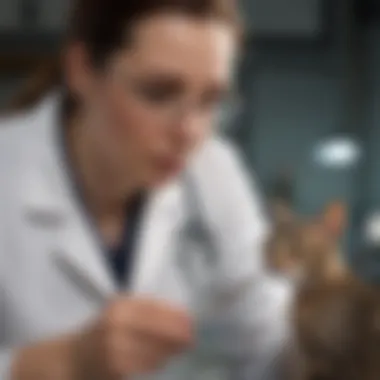Recognizing Gastrointestinal Blockage Signs in Pets


Intro
Gastrointestinal blockage in pets, particularly in cats and dogs, poses a serious risk that pet owners must recognize quickly. Awareness and understanding of the signs can impact the timely intervention needed to ensure your pet's well-being. This article aims to provide pet owners with detailed insights into the signs of gastrointestinal blockage, intricate physiological behaviors and symptoms, and effective ways to diagnose and treat this condition.
Understanding Your Pet
Understanding your pet's individual traits and behaviors is crucial for identifying potential health issues.
Breed Traits
Some dog and cat breeds have predispositions to certain gastrointestinal problems. Breeds such as German Shepherds and Golden Retrievers are known for their susceptibility to bloat, while cats like Persians may face different challenges. Recognizing these breed-specific traits provides insight into their health needs.
Common Temperaments
Your pet's temperament can affect its behavior. A calm pet may show subtle signs of distress, whereas a more anxious animal could display obvious symptoms of discomfort. Understanding your pet’s usual demeanor will help you notice changes that may indicate a problem.
Special Needs
Certain pets have special needs due to age, health issues, or breed. These factors can complicate gastrointestinal health. Older pets may have slower digestion and require different diets to minimize risks.
Pet Care Essentials
Proper care can help prevent gastrointestinal issues.
Nutrition and Feeding Guidelines
Adhering to proper nutrition is fundamental. High-quality diets tailored to an animal’s specific needs can prevent gastrointestinal distress. For example, certain fibers can help minimize the risk of blockages.
Grooming Tips and Techniques
Regular grooming can reduce hair ingestion in cats and dogs, a common cause of gastrointestinal issues. This effort goes beyond aesthetics; it has health benefits as well.
Health and Wellness
Maintaining regular veterinary check-ups allows for early detection of potential problems. This investment in your pet's health can lead to a longer and happier life.
Training and Behavior
Educating your pet leads to better health understanding.
Basic Training Techniques
Implementing basic commands can help in managing food intake and preventing access to harmful items.
Behavioral Problems and Solutions
Certain behaviors, such as scavenging, can increase the risk of ingestion of foreign objects. Addressing these through training can limit this risk.
Mental Stimulation Activities
Engaging your pet mentally can reduce anxiety and boredom, which may lead to undesirable behaviors, including eating inappropriate items.
Engaging with Your Pet
Fostering relationships helps in monitoring their health.
Interactive Games and Toys
Playtime is vital. Providing safe toys discourages destructive chewing or swallowing dangerous items.
Safe Outdoor Activities
Exposing pets to secure outdoor environments ensures they explore without the risk of finding items that could cause blockages.
Family-Friendly Pet Interactions
Teaching family members about safe interactions with pets fosters an understanding of how to care for them properly.


Pet Adoption and Integration
The journey begins with adoption.
Choosing the Right Pet for Your Lifestyle
Selecting a pet that fits your lifestyle minimizes stress for both you and the animal. This consideration can lead to better health outcomes.
Preparing Your Home for a New Pet
A safe home reduces risks. Removing dangerous items and adjusting spaces can ensure your new pet is safe.
Tips for Smooth Prelude
Smooth introductions between pets and family members, including other pets, encourage a harmonious living environment.
Thorough understanding and proactive steps contribute significantly to your pet’s health. By recognizing the signs of gastrointestinal blockage early, pet owners can take appropriate action quickly.
Intro to Gastrointestinal Blockage
Gastrointestinal blockage is a condition that can pose a serious threat to pets, particularly dogs and cats. Understanding this topic can significantly enhance a pet owner's capacity to recognize and respond to potential health issues. When an animal's digestive tract becomes obstructed, it interrupts the normal flow of food and waste, leading to various metabolic complications. This article will focus on the essential features surrounding gastrointestinal blockages.
Timely awareness and recognition of blockage signs can save a pet's life. Therefore, knowing about gastrointestinal blockages is critical for every pet owner. Being informed can also lead to better preventive measures and care strategies.
What is Gastrointestinal Blockage?
Gastrointestinal blockage occurs when there is an impediment in the gastrointestinal tract. This condition can take many forms, including partial or total blockage. It can disrupt the passage of contents through the stomach, intestines, or both. The impacts of this condition can range from mild discomfort to severe health risks, including fatality in some cases.
Blockage can stem from various sources, such as ingested foreign objects, tumors, or severe inflammatory conditions. Pets may exhibit discomfort due to the inability to process food efficiently, leading to additional issues like dehydration and malnutrition. Therefore, understanding what gastrointestinal blockage entails is the first step in safeguarding your pet's health.
Common Causes of GI Blockage
Numerous factors can lead to gastrointestinal blockage in pets. Some of the most common causes include:
- Ingested Foreign Objects: Pets, especially young ones, often chew and swallow items that don’t belong in their diet. This can include toys, string, or even clothing.
- Tumors: Growths in the gastrointestinal tract may hinder the passage of food or waste, leading to obstruction.
- Intestinal Folding: This condition, known as intussusception, occurs when a portion of the intestine folds into itself, creating a blockage.
- Thickened Gut Tissue: Inflammatory conditions, such as inflammatory bowel disease, can thicken the intestinal walls and restrict flow.
- Parasitic Infections: Heavy infestations of parasites can also lead to blockages in the intestines.
Recognition of these causes can aid in preventing gastrointestinal blockages by minimizing risks through careful supervision of pets and appropriate dietary choices.
Recognizing the Symptoms of GI Blockage
Recognizing the signs of gastrointestinal blockage in pets is crucial for timely intervention and treatment. This segment provides insights into behavioral and physical symptoms that can indicate a blockage. Understanding these symptoms allows pet owners to make informed decisions and seek veterinary assistance when needed. Early recognition can significantly impact the pet’s health and recovery process.
Behavioral Indications
Behavioral changes in pets are often the first signs of discomfort or illness. Observing these changes can guide pet owners in recognizing gastrointestinal blockage.
Changes in Appetite
Changes in appetite are a significant indicator of gastrointestinal distress. When a pet suddenly refuses to eat or shows disinterest in food, this may signify an underlying issue. Pets may experience nausea or discomfort, often leading to these changes. This symptom is notable because a loss of appetite is typically one of the earliest signs pet owners may notice. Ignoring a pet's altered eating habits can delay diagnosis and treatment of gastrointestinal blockage.
Restlessness or Lethargy
Restlessness or lethargy can indicate a range of health problems, including gastrointestinal issues. A pet may exhibit increased pacing or nervousness, or it may seem unusually tired and disinterested in activities it usually enjoys. This duality is critical because it reflects how the pet is coping with discomfort. For instance, a previously active dog suddenly becoming inactive may signal the need for a veterinary visit. Paying attention to these symptoms helps in monitoring the pet's well-being.
Vocalizations
Vocalizations such as whining, growling, or excessive meowing can be a response to pain or discomfort related to gastrointestinal blockage. Pets may express their distress through their vocalizations, and changes in their usual sounds can indicate an urgent health issue. This symptom is important because it serves as a clear communication method from the pet to the owner. Understanding what these vocalizations mean can aid in early detection and intervention, mitigating potential complications.
Physical Symptoms
Physical symptoms provide observable evidence of gastrointestinal blockage. These symptoms often require prompt attention and can greatly inform veterinary assessments.
Vomiting
Vomiting is one of the more obvious signs of gastrointestinal blockage. It can vary from occasional to persistent, and the presence of bile or undigested food can give additional clues about the condition's severity. This symptom is significant because it may indicate that food or liquid is unable to move through the digestive tract. Recognizing vomiting quickly can lead to timely veterinary care, which may be critical for the pet's health.
Diarrhea


Diarrhea is another important physical symptom to note. It can range from mild to severe and may be accompanied by a change in consistency and color. This symptom can signify that the body is attempting to expel an obstruction. Monitoring the frequency and severity of diarrhea is essential, as it can lead to dehydration. Dewhydration poses its own risks and complications, making early recognition key.
Abdominal Distension
Abdominal distension, or bloating, can be alarming for pet owners. A visibly swollen abdomen can indicate a blockage, which may cause pressure in the gastrointestinal tract. Observing a pet’s abdomen for signs of bloating is valuable, as this symptom often correlates with discomfort or pain. Addressing abdominal distension promptly helps prevent further complications and assists in guiding veterinary evaluations.
Constipation
Constipation may seem minor but can signal significant gastrointestinal issues. If a pet is straining to defecate or producing hard stools, it can indicate a blockage further down the intestinal tract. This symptom is crucial because it can lead to discomfort and complicate an existing condition. Monitoring changes in bowel habits may provide vital information for a veterinarian when assessing the situation.
Acute vs.
Chronic GI Blockage
Understanding the distinction between acute and chronic gastrointestinal (GI) blockage is crucial for pet owners. Recognizing these types helps in determining the urgency and type of treatment required. Acute GI blockage occurs suddenly, often necessitating immediate medical attention. In contrast, chronic blockage develops gradually, which might mislead owners into delaying examination. Knowing the signs and implications of each can significantly affect outcomes for affected pets.
Identifying Acute Blockage
Acute gastrointestinal blockage can present with sudden and severe symptoms. Pet owners should be vigilant for signs that may indicate an urgent condition.
- Sudden Vomiting: Frequent or projectile vomiting is a common symptom.
- Abdominal Pain: Pets may show signs of pain such as whining or reluctance to be touched.
- Lethargy: An affected pet often becomes unusually tired or inactive.
- Bloating: The abdomen may appear distended or swollen.
In acute cases, time is an essential factor. If you observe these signs, it is advisable to consult a veterinarian as soon as possible. Delay may lead to serious health risks, including organ failure.
Understanding Chronic Blockage
Chronic gastrointestinal blockage is often more subtle, with symptoms that may develop over time. This gradual onset can lead to misinterpretation of the condition.
- Intermittent Vomiting: Unlike acute episodes, vomiting may occur sporadically.
- Weight Loss: Unexplained loss of weight can be a key indicator.
- Altered Appetite: Pets may show decreased interest in food or eat less than usual.
- Persistent Diarrhea or Constipation: Fluctuating bowel movements might arise due to a partial blockage.
Monitoring these symptoms is essential for early detection of chronic blockage. Regular veterinary check-ups can help in identifying underlying issues that might not be immediately apparent.
Early intervention can prevent significant health complications. Recognizing the difference between acute and chronic GI blockage allows for appropriate action.
The Importance of Timely Diagnosis
Gastrointestinal blockage in pets can lead to severe consequences if not diagnosed promptly. Understanding the importance of early diagnosis is essential for all pet owners. When a blockage occurs, it interferes with the pet's normal digestive process. This can result in pain, discomfort, and serious health issues that could even be fatal.
Timely diagnosis allows for swift intervention, which is critical in cases of acute blockages. Early identification can minimize complications, reduce recovery time, and improve the overall prognosis. Neglecting early signs can lead to more extensive medical procedures and higher costs. Pet owners should be proactive rather than reactive when it comes to their animal's health.
Consulting a Veterinarian
Consulting a veterinarian is the most crucial step in diagnosing gastrointestinal blockage. They possess the knowledge and training necessary to assess symptoms accurately. When a pet exhibits signs consistent with GI blockage, a veterinarian can perform a thorough examination, asking specific questions about the pet's behavior, diet, and recent activities. This information is vital for determining the likelihood of a blockage.
The veterinarian may recommend immediate diagnostic tests, which are essential for confirming or ruling out a blockage. Professionals can recognize subtle signs that an untrained eye might miss, enhancing the chances of an accurate diagnosis. Engaging a veterinarian promptly can significantly impact treatment options and outcomes.
Diagnostic Techniques
Imaging Techniques
Imaging techniques are a standard part of diagnosing gastrointestinal blockage. X-rays and ultrasound are the most common forms of imaging used in this context. X-rays can reveal the presence of foreign objects and the general state of the GI tract. Ultrasound provides detailed images of the organs, making it easier to assess blockages, fluid levels, or masses.
One key characteristic of imaging techniques is their non-invasive nature. This is beneficial, especially in cases where the pet is unstable. Understanding the blockage's location and severity without invasive testing leads to quicker decision-making. However, these methods also have limitations, such as the potential for false negatives, which can complicate diagnosis if results appear normal despite the presence of a blockage.
Endoscopy
Endoscopy is another technique used for diagnosing gastrointestinal blockage. This procedure involves inserting a flexible tube with a camera into the pet's digestive tract. It allows veterinarians to visualize the inside of the GI tract directly. Moreover, endoscopy can be used to remove small foreign objects without the need for surgery, making it a less invasive option.
A significant advantage of endoscopy is that it provides real-time visualization of the blockage and surrounding tissues. However, it requires sedation, and not all pets are suitable candidates for this procedure. In some cases, an endoscopy may not reach the blockage area, limiting its effectiveness.
Blood Tests
Blood tests also play a vital role in diagnosing gastrointestinal blockage. They help identify underlying issues and assess the overall health of the pet. Common blood tests include complete blood counts and biochemistry panels. These tests provide insight into organ function and possible infections, helping guide the diagnosis further.
One key characteristic of blood tests is that they can detect systemic effects of a blockage, such as dehydration or electrolyte imbalances. This early detection can influence treatment plans significantly. However, blood tests alone cannot pinpoint a blockage's location, making them complement rather than replace imaging techniques or endoscopy.
In summary, timely diagnosis of gastrointestinal blockage in pets is crucial. Consulting a veterinarian and utilizing diagnostic techniques like imaging, endoscopy, and blood tests allows for early intervention, ensuring better outcomes for the pet.


Treatment Options for GI Blockage
Understanding the signs of gastrointestinal blockage is crucial for pet owners. Knowing how to treat a blockage can prevent serious health issues in cats and dogs. The right treatment ensures quick recovery and improves the quality of life for pets. This section covers options that can alleviate the problems caused by GI blockage, focusing on both surgical and non-surgical approaches.
Surgical Intervention
Surgical intervention is typically the most direct method of treating gastrointestinal blockage. In severe cases, it may become necessary to remove the obstruction surgically. This method allows veterinarians to physically clear the blockage, which may consist of foreign objects or tissue that has formed inside the digestive tract.
Key Considerations for Surgery:
- When it is Necessary: Surgery is often needed when non-surgical methods fail, or the blockage poses immediate risk to the pet's health.
- Risks Involved: As with any surgical procedure, there are inherent risks, including infection, anesthesia complications, and recovery concerns.
- Recovery Process: Post-surgery, pets require proper care. This includes monitoring for pain, offering medications, and following dietary restrictions to aid in healing.
Surgical outcomes can vary, but many pets recover well and return to normal activity after appropriate care and healing time.
Non-Surgical Treatment Approaches
Non-surgical options can also be effective, particularly for less severe blockages. Promoting natural processes in the digestive system may help alleviate the problem without the need for surgery.
Options Include:
- Fluid Therapy: Administering fluids either orally or intravenously can help to hydrate your pet and facilitate the movement of contents through the digestive system.
- Medications: Laxatives or anti-nausea medications might be prescribed to relieve symptoms and help in passing the blockage.
- Dietary Changes: Feeding a special diet that is easier to digest can support recovery. Some vets recommend a diet high in fiber, which may help push the obstruction through.
Benefits of Non-Surgical Approaches:
- Less Invasive: These treatments often entail less risk compared to surgery.
- Easier to Manage: Most of these methods can be administered at home under veterinary guidance.
- Cost-effective: Generally, non-surgical treatments are less expensive than surgical options.
However, it is essential to monitor the situation closely. If symptoms persist or worsen, surgical options might need to be reconsidered.
Preventative Measures for GI Blockage
Preventing gastrointestinal blockage in pets is a crucial aspect of ensuring their long-term health and well-being. Awareness and proactive measures can substantially reduce the incidence of these potentially life-threatening conditions. By understanding and implementing simple strategies, owners can significantly lower the risks associated with both acute and chronic blockages. This section delves into the two primary areas that require attention: dietary considerations and routine veterinary check-ups.
Dietary Considerations
One of the fundamental aspects of preventing gastrointestinal blockage lies in managing your pet's diet. Feeding pets a well-balanced and appropriate diet is essential. Here are several key considerations:
- Quality of Food: Choose high-quality pet food that meets the specific nutritional needs of your pet. This may vary by age, size, and breed. Look for options that include digestible proteins and fibers.
- Avoiding Human Food: Certain human foods can be harmful, especially items like bones, which can splinter, and fatty foods that may lead to digestive issues. Stick to pet-formulated products.
- Monitoring Food Intake: Regularly measure your pet's food portion. Overeating can lead to obesity, which is a risk factor for digestive problems.
- Hydration: Ensure your pet has constant access to fresh water. Dehydration can lead to constipation, which can worsen blockage conditions.
- Frequent Meals: Consider offering smaller, more frequent meals rather than one or two large ones. This can aid digestion and help prevent blockages.
By focusing on these dietary elements, pet owners can support optimal digestive health and reduce the risk of gastrointestinal blockages.
Routine Veterinary Check-ups
Regular visits to the veterinarian play an integral role in the early detection and prevention of gastrointestinal blockage. Scheduling routine check-ups is beneficial for several reasons:
- Health Monitoring: A veterinarian can assess your pet's overall health, including weight, dental health, and signs of digestive issues.
- Preventive Screenings: During check-ups, vets can perform screenings or recommend tests that may identify underlying conditions contributing to GI blockage risk.
- Vaccination and Prevention: Keeping vaccinations up-to-date can prevent diseases that might lead to digestive problems. Regular check-ups ensure you stay on track with required vaccines.
- Nutritional Guidance: Vets can provide personalized dietary recommendations tailored to your pet's health status, age, and breed.
- Behavioral Observations: Routine visits allow veterinarians to observe behavioral changes that could indicate digestive issues, providing insight that owners might miss.
In summary, proactive healthcare and preventive measures are essential in safeguarding against gastrointestinal blockages in pets. Establishing good dietary practices and maintaining regular veterinary appointments are key strategies every pet owner should prioritize.
"An ounce of prevention is worth a pound of cure." - Benjamin Franklin
Adopting these strategies supports both the immediate and long-term health of your animal companions.
Epilogue
Understanding gastrointestinal blockage in pets is essential for ensuring their health and well-being. This article has explored various aspects of GI blockage, emphasizing the importance of recognizing signs early. Proactive measures and timely interventions can significantly enhance the prognosis for affected animals.
Summarizing Key Points
Throughout the article, we highlighted several crucial indicators that pet owners should observe. These inclued:
- Behavioral changes: Noticeable shifts in appetite, energy levels, and normal activities can signal distress.
- Physical symptoms: Vomiting, diarrhea, and abdominal distension are common physical signs of blockage.
- Acute vs. chronic blockage: Distinguishing between these two types aids in determining urgent care needs.
- Diagnostic procedures: Engaging a veterinarian for proper diagnosis using imaging and blood tests is vital.
- Treatment options: Both surgical and non-surgical methods exist for addressing GI blockage depending on severity.
- Preventative care: Adopting a balanced diet and regular veterinary visits can prevent future occurrences.
The emphasis on these points helps create awareness and guides pet owners in monitoring their companions more closely.
Encouraging Proactive Pet Care
To encourage proactive pet care, owners should consider the following elements:
- Regular monitoring: Keep an eye on your pet’s eating habits, behavior, and bowel movements to identify any changes promptly.
- Quality diet: Invest in high-quality pet food that meets your pet's specific nutritional needs. This can go a long way in preventing gastrointestinal issues.
- Veterinary visits: Ensure routine check-ups to catch potential issues before they escalate into emergencies.
By taking these proactive steps, pet owners can significantly reduce the risk of gastrointestinal blockage and support their pets' overall health effectively.
Feeling connected with your pet means paying attention and acting accordingly in times of change. Prioritize their health and well-being.



